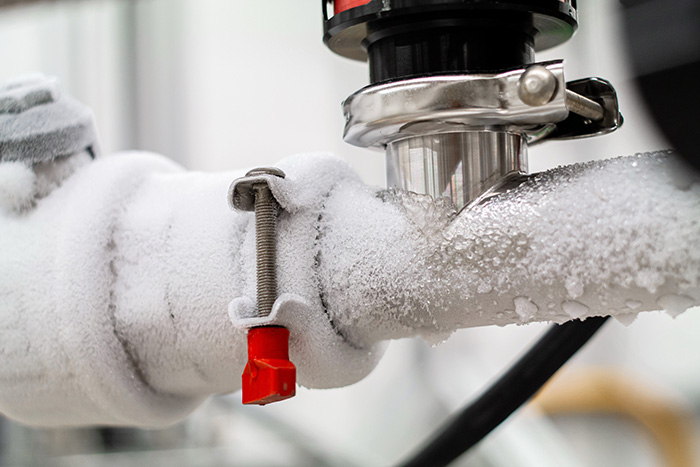Protecting Against Frozen Plumbing in Winter: Expert Strategies
Protecting Against Frozen Plumbing in Winter: Expert Strategies
Blog Article
The content further down involving How to Prevent Your Pipes From Freezing is highly compelling. You should take a look.

Cold weather can damage your pipes, particularly by freezing pipelines. Right here's just how to stop it from taking place and what to do if it does.
Introduction
As temperature levels drop, the risk of frozen pipes rises, potentially causing pricey fixings and water damages. Recognizing exactly how to stop frozen pipes is essential for home owners in chilly climates.
Recognizing Icy Pipelines
What causes pipelines to freeze?
Pipelines freeze when revealed to temperatures listed below 32 ° F (0 ° C) for expanded periods. As water inside the pipes freezes, it expands, putting pressure on the pipe walls and potentially triggering them to rupture.
Dangers and problems
Icy pipes can result in water system disturbances, building damage, and pricey repair work. Ruptured pipelines can flood homes and cause extensive structural damage.
Indications of Frozen Pipeline
Determining icy pipelines early can avoid them from bursting.
Exactly how to identify icy pipes
Search for decreased water flow from faucets, uncommon smells or noises from pipelines, and noticeable frost on subjected pipes.
Avoidance Tips
Shielding susceptible pipelines
Cover pipes in insulation sleeves or utilize warmth tape to safeguard them from freezing temperatures. Focus on pipelines in unheated or external locations of the home.
Home heating strategies
Maintain indoor spaces adequately warmed, specifically locations with plumbing. Open up closet doors to permit warm air to flow around pipes under sinks.
Protecting Outdoor Plumbing
Garden pipes and exterior taps
Separate and drain pipes yard pipes before winter months. Install frost-proof faucets or cover outdoor faucets with insulated caps.
What to Do If Your Pipes Freeze
Immediate activities to take
If you believe frozen pipelines, keep faucets open to alleviate pressure as the ice melts. Use a hairdryer or towels soaked in warm water to thaw pipelines gradually.
Long-Term Solutions
Architectural changes
Consider rerouting pipes away from outside wall surfaces or unheated areas. Add extra insulation to attics, basements, and crawl spaces.
Upgrading insulation
Purchase premium insulation for pipes, attic rooms, and wall surfaces. Correct insulation aids preserve consistent temperature levels and decreases the danger of icy pipelines.
Final thought
Preventing icy pipelines calls for positive steps and fast reactions. By recognizing the causes, indicators, and preventive measures, property owners can protect their pipes throughout cold weather.
6 Proven Ways to Prevent Frozen Pipes and Protect Your Home
Disconnect and Drain Garden Hoses
Before winter arrives, start by disconnecting your garden hoses and draining any remaining water. Close the shut-off valves that supply outdoor hose bibs and leave the outdoor faucet open to allow any residual water to drain. For extra protection, consider using faucet covers throughout the colder months. It’s also important to drain water from any sprinkler supply lines following the manufacturer’s directions.
Insulate Exposed Pipes
Insulating your pipes is an effective way to prevent freezing. Pipe insulation is readily available at home improvement stores and is relatively inexpensive. Pay close attention to pipes in unheated areas such as the attic, basement, crawl spaces, or garage. Apply foam insulation generously to create a buffer against the cold. You can also wrap your pipes in heat tape or thermostat-controlled heat cables for added warmth.
Seal Air Leaks
Inspect your home for any cracks or openings that could let in cold air. Seal any holes around the piping in interior or exterior walls, as well as the sill plates where your home rests on its foundation. Additionally, make sure to keep your garage door closed unless you’re entering or exiting. Leaving it open creates a significant air leak that can lead to frozen pipes.
Allow Warm Air Circulation
During cold snaps, it’s essential to allow warm air to circulate evenly throughout your home. Leave interior doors ajar to promote better airflow. Open kitchen and bathroom cabinets to help distribute heat consistently around the rooms. If you have small children or pets, be sure to remove any household chemicals or potentially harmful cleaners from open cabinets for safety.
Let Faucets Drip
A small trickle of water can make a big difference in preventing ice formation inside your pipes. When temperatures drop significantly, start a drip of water from all faucets served by exposed pipes. This continuous flow helps prevent the water from freezing. Additionally, running a few faucets slightly can relieve pressure inside the pipes, reducing the chances of a rupture if the water inside does freeze.
https://choateshvac.com/6-proven-ways-to-prevent-frozen-pipes-and-protect-your-home/

I was made aware of that report on 6 Ways to Prevent Frozen Pipes through a good friend on our other web blog. Are you aware of another person who is enthusiastic about the topic? Why not promote it. Thanks a bunch for being here. Return soon.
Check This Out Report this page